BSBWHS501 Ensure a Safe Workplace: Mining Safety Policy Development
VerifiedAdded on 2023/06/11
|15
|5079
|493
Homework Assignment
AI Summary
This assignment solution for BSBWHS501 'Ensure a Safe Workplace' covers various aspects of workplace health and safety, including identifying forms, registers, and records used to collect information on WHS incidents, injuries, and near misses. It explores how analyzing these records can improve WHS performance. The assignment also addresses the implementation and monitoring of WHS procedures, methods for explaining legislative requirements, and conducting training needs analyses. Furthermore, it examines potential outcomes of inadequate risk controls and provides examples of workplace hazards and hazard identification methods. A scenario involving a mining firm is presented, requiring the development of WHS policies and procedures, including standard operating procedures for machinery, PPE usage, hazardous substance management, and first-aid procedures. Desklib offers a platform to access this and other solved assignments for students.
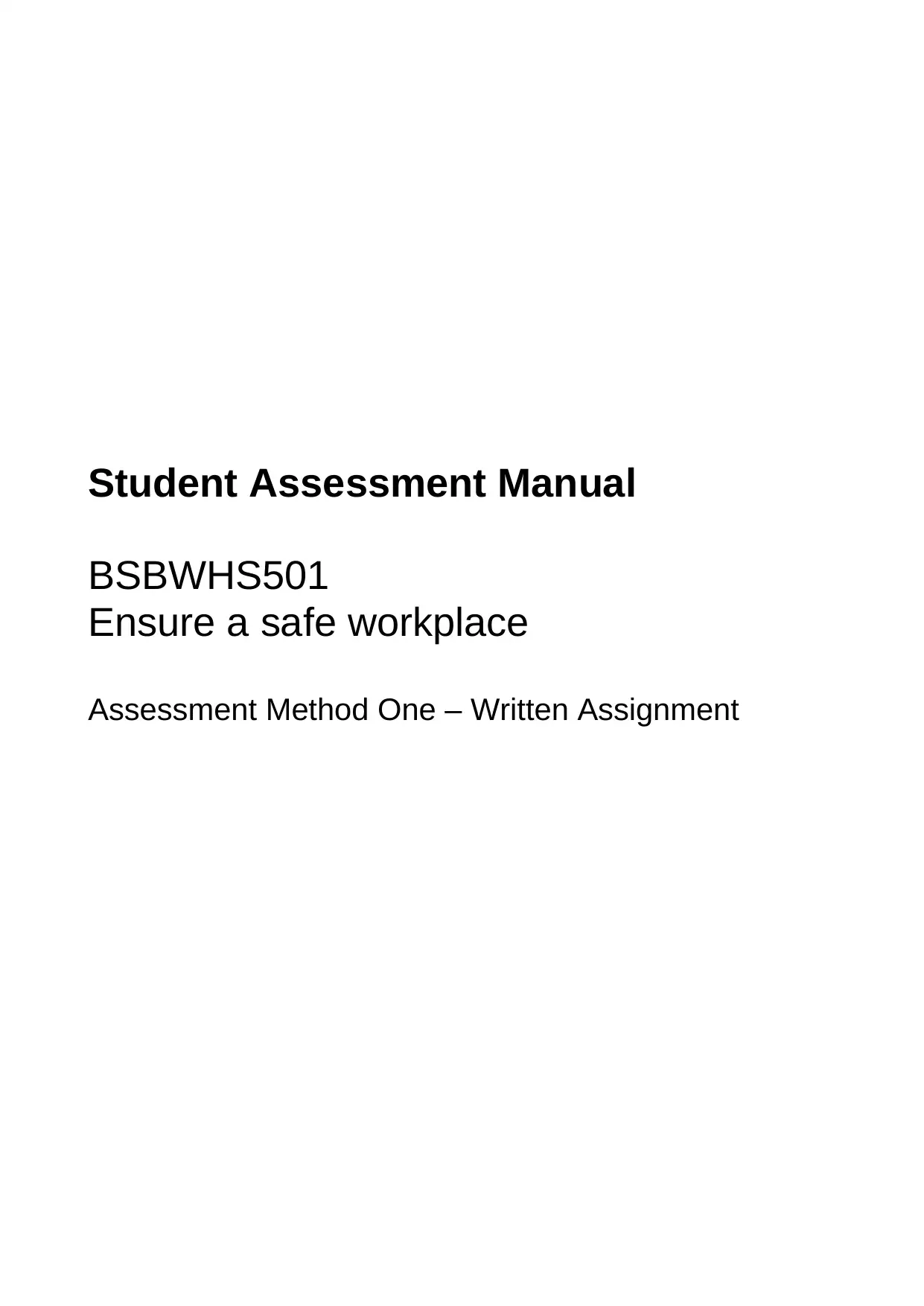
Student Assessment Manual
BSBWHS501
Ensure a safe workplace
Assessment Method One – Written Assignment
BSBWHS501
Ensure a safe workplace
Assessment Method One – Written Assignment
Paraphrase This Document
Need a fresh take? Get an instant paraphrase of this document with our AI Paraphraser
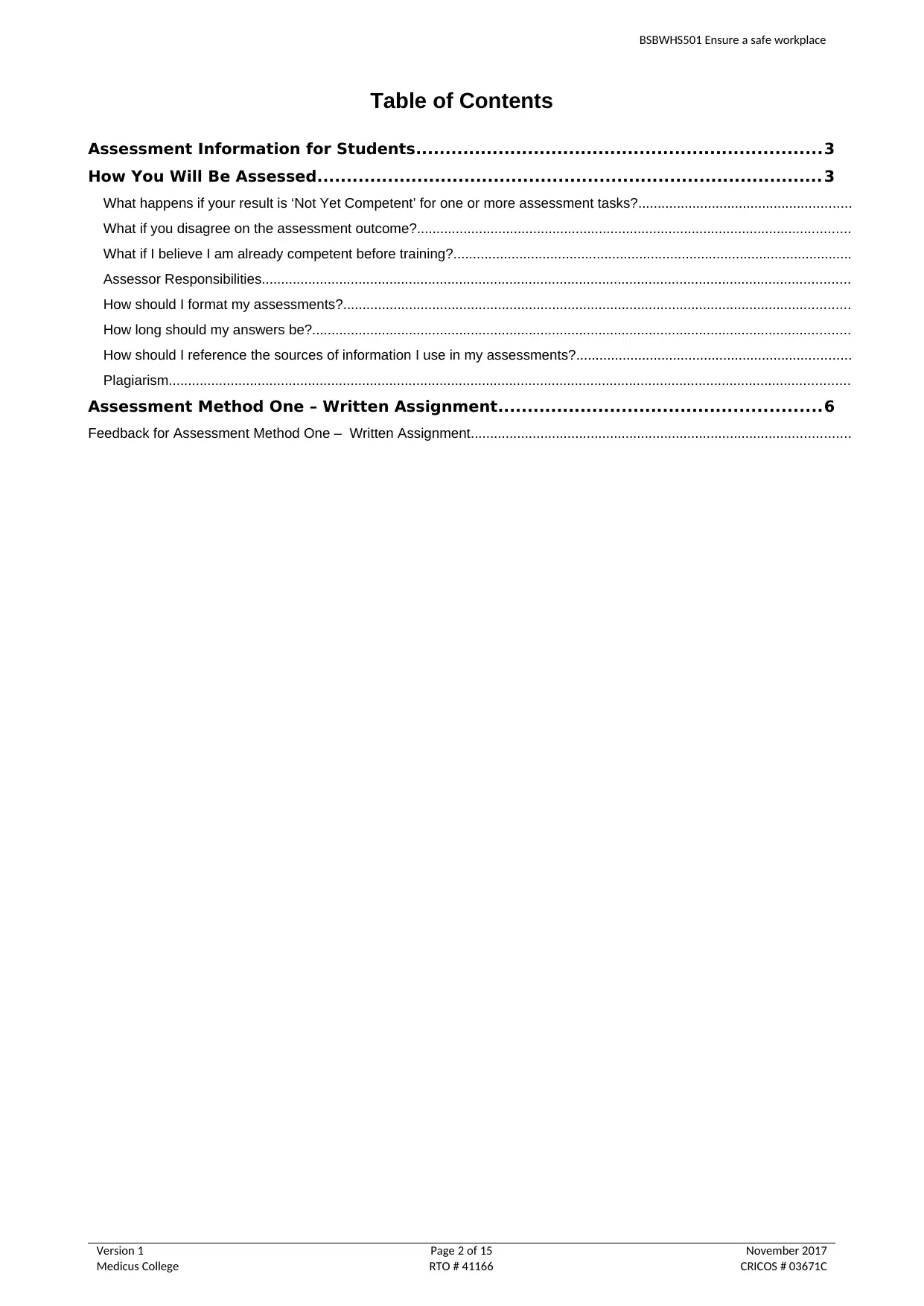
BSBWHS501 Ensure a safe workplace
Table of Contents
Assessment Information for Students.....................................................................3
How You Will Be Assessed......................................................................................3
What happens if your result is ‘Not Yet Competent’ for one or more assessment tasks?.......................................................
What if you disagree on the assessment outcome?................................................................................................................
What if I believe I am already competent before training?.......................................................................................................
Assessor Responsibilities........................................................................................................................................................
How should I format my assessments?...................................................................................................................................
How long should my answers be?...........................................................................................................................................
How should I reference the sources of information I use in my assessments?.......................................................................
Plagiarism................................................................................................................................................................................
Assessment Method One – Written Assignment.......................................................6
Feedback for Assessment Method One – Written Assignment..................................................................................................
Version 1 Page 2 of 15 November 2017
Medicus College RTO # 41166 CRICOS # 03671C
Table of Contents
Assessment Information for Students.....................................................................3
How You Will Be Assessed......................................................................................3
What happens if your result is ‘Not Yet Competent’ for one or more assessment tasks?.......................................................
What if you disagree on the assessment outcome?................................................................................................................
What if I believe I am already competent before training?.......................................................................................................
Assessor Responsibilities........................................................................................................................................................
How should I format my assessments?...................................................................................................................................
How long should my answers be?...........................................................................................................................................
How should I reference the sources of information I use in my assessments?.......................................................................
Plagiarism................................................................................................................................................................................
Assessment Method One – Written Assignment.......................................................6
Feedback for Assessment Method One – Written Assignment..................................................................................................
Version 1 Page 2 of 15 November 2017
Medicus College RTO # 41166 CRICOS # 03671C
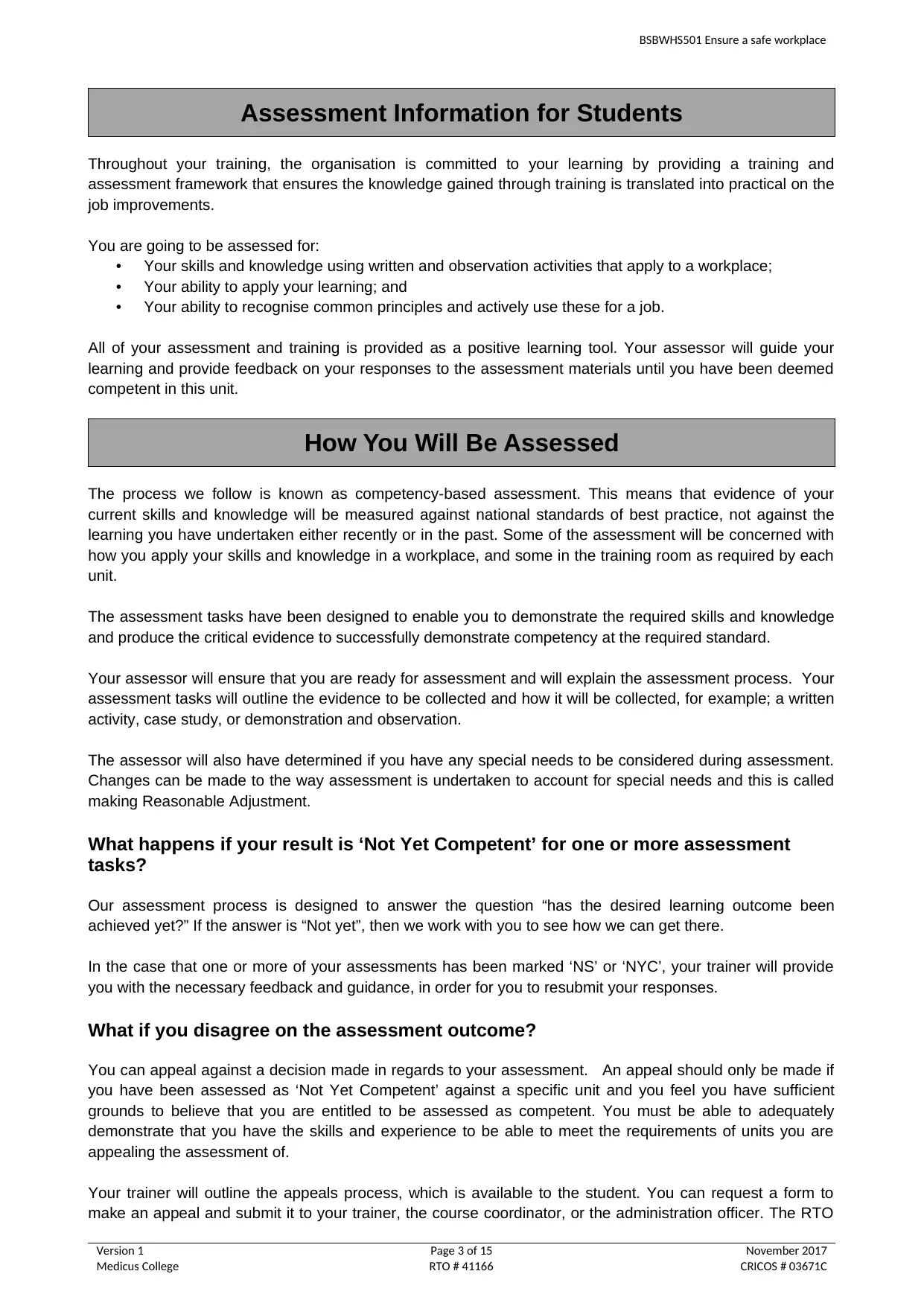
BSBWHS501 Ensure a safe workplace
Assessment Information for Students
Throughout your training, the organisation is committed to your learning by providing a training and
assessment framework that ensures the knowledge gained through training is translated into practical on the
job improvements.
You are going to be assessed for:
• Your skills and knowledge using written and observation activities that apply to a workplace;
• Your ability to apply your learning; and
• Your ability to recognise common principles and actively use these for a job.
All of your assessment and training is provided as a positive learning tool. Your assessor will guide your
learning and provide feedback on your responses to the assessment materials until you have been deemed
competent in this unit.
How You Will Be Assessed
The process we follow is known as competency-based assessment. This means that evidence of your
current skills and knowledge will be measured against national standards of best practice, not against the
learning you have undertaken either recently or in the past. Some of the assessment will be concerned with
how you apply your skills and knowledge in a workplace, and some in the training room as required by each
unit.
The assessment tasks have been designed to enable you to demonstrate the required skills and knowledge
and produce the critical evidence to successfully demonstrate competency at the required standard.
Your assessor will ensure that you are ready for assessment and will explain the assessment process. Your
assessment tasks will outline the evidence to be collected and how it will be collected, for example; a written
activity, case study, or demonstration and observation.
The assessor will also have determined if you have any special needs to be considered during assessment.
Changes can be made to the way assessment is undertaken to account for special needs and this is called
making Reasonable Adjustment.
What happens if your result is ‘Not Yet Competent’ for one or more assessment
tasks?
Our assessment process is designed to answer the question “has the desired learning outcome been
achieved yet?” If the answer is “Not yet”, then we work with you to see how we can get there.
In the case that one or more of your assessments has been marked ‘NS’ or ‘NYC’, your trainer will provide
you with the necessary feedback and guidance, in order for you to resubmit your responses.
What if you disagree on the assessment outcome?
You can appeal against a decision made in regards to your assessment. An appeal should only be made if
you have been assessed as ‘Not Yet Competent’ against a specific unit and you feel you have sufficient
grounds to believe that you are entitled to be assessed as competent. You must be able to adequately
demonstrate that you have the skills and experience to be able to meet the requirements of units you are
appealing the assessment of.
Your trainer will outline the appeals process, which is available to the student. You can request a form to
make an appeal and submit it to your trainer, the course coordinator, or the administration officer. The RTO
Version 1 Page 3 of 15 November 2017
Medicus College RTO # 41166 CRICOS # 03671C
Assessment Information for Students
Throughout your training, the organisation is committed to your learning by providing a training and
assessment framework that ensures the knowledge gained through training is translated into practical on the
job improvements.
You are going to be assessed for:
• Your skills and knowledge using written and observation activities that apply to a workplace;
• Your ability to apply your learning; and
• Your ability to recognise common principles and actively use these for a job.
All of your assessment and training is provided as a positive learning tool. Your assessor will guide your
learning and provide feedback on your responses to the assessment materials until you have been deemed
competent in this unit.
How You Will Be Assessed
The process we follow is known as competency-based assessment. This means that evidence of your
current skills and knowledge will be measured against national standards of best practice, not against the
learning you have undertaken either recently or in the past. Some of the assessment will be concerned with
how you apply your skills and knowledge in a workplace, and some in the training room as required by each
unit.
The assessment tasks have been designed to enable you to demonstrate the required skills and knowledge
and produce the critical evidence to successfully demonstrate competency at the required standard.
Your assessor will ensure that you are ready for assessment and will explain the assessment process. Your
assessment tasks will outline the evidence to be collected and how it will be collected, for example; a written
activity, case study, or demonstration and observation.
The assessor will also have determined if you have any special needs to be considered during assessment.
Changes can be made to the way assessment is undertaken to account for special needs and this is called
making Reasonable Adjustment.
What happens if your result is ‘Not Yet Competent’ for one or more assessment
tasks?
Our assessment process is designed to answer the question “has the desired learning outcome been
achieved yet?” If the answer is “Not yet”, then we work with you to see how we can get there.
In the case that one or more of your assessments has been marked ‘NS’ or ‘NYC’, your trainer will provide
you with the necessary feedback and guidance, in order for you to resubmit your responses.
What if you disagree on the assessment outcome?
You can appeal against a decision made in regards to your assessment. An appeal should only be made if
you have been assessed as ‘Not Yet Competent’ against a specific unit and you feel you have sufficient
grounds to believe that you are entitled to be assessed as competent. You must be able to adequately
demonstrate that you have the skills and experience to be able to meet the requirements of units you are
appealing the assessment of.
Your trainer will outline the appeals process, which is available to the student. You can request a form to
make an appeal and submit it to your trainer, the course coordinator, or the administration officer. The RTO
Version 1 Page 3 of 15 November 2017
Medicus College RTO # 41166 CRICOS # 03671C
⊘ This is a preview!⊘
Do you want full access?
Subscribe today to unlock all pages.

Trusted by 1+ million students worldwide
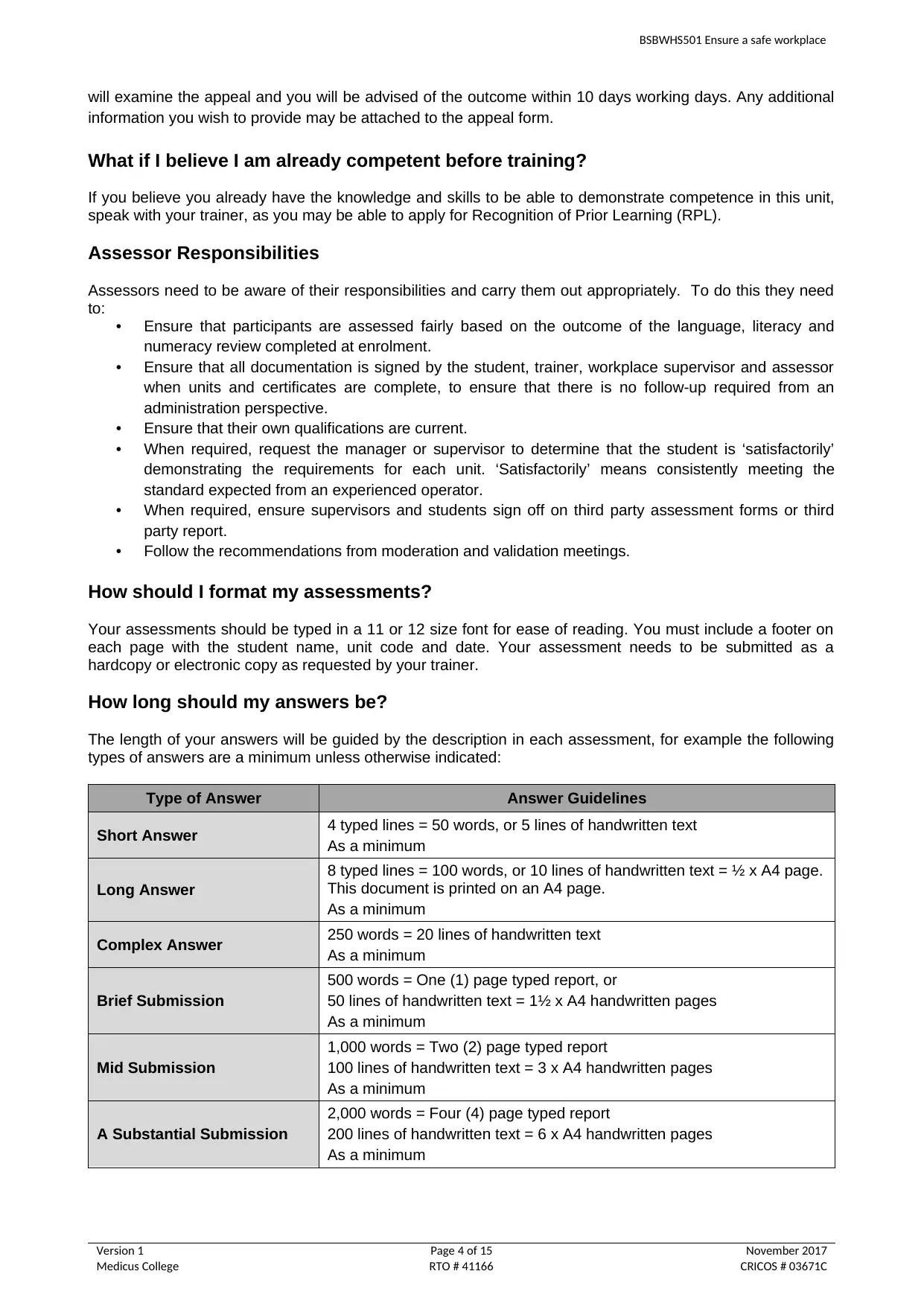
BSBWHS501 Ensure a safe workplace
will examine the appeal and you will be advised of the outcome within 10 days working days. Any additional
information you wish to provide may be attached to the appeal form.
What if I believe I am already competent before training?
If you believe you already have the knowledge and skills to be able to demonstrate competence in this unit,
speak with your trainer, as you may be able to apply for Recognition of Prior Learning (RPL).
Assessor Responsibilities
Assessors need to be aware of their responsibilities and carry them out appropriately. To do this they need
to:
• Ensure that participants are assessed fairly based on the outcome of the language, literacy and
numeracy review completed at enrolment.
• Ensure that all documentation is signed by the student, trainer, workplace supervisor and assessor
when units and certificates are complete, to ensure that there is no follow-up required from an
administration perspective.
• Ensure that their own qualifications are current.
• When required, request the manager or supervisor to determine that the student is ‘satisfactorily’
demonstrating the requirements for each unit. ‘Satisfactorily’ means consistently meeting the
standard expected from an experienced operator.
• When required, ensure supervisors and students sign off on third party assessment forms or third
party report.
• Follow the recommendations from moderation and validation meetings.
How should I format my assessments?
Your assessments should be typed in a 11 or 12 size font for ease of reading. You must include a footer on
each page with the student name, unit code and date. Your assessment needs to be submitted as a
hardcopy or electronic copy as requested by your trainer.
How long should my answers be?
The length of your answers will be guided by the description in each assessment, for example the following
types of answers are a minimum unless otherwise indicated:
Type of Answer Answer Guidelines
Short Answer 4 typed lines = 50 words, or 5 lines of handwritten text
As a minimum
Long Answer
8 typed lines = 100 words, or 10 lines of handwritten text = ½ x A4 page.
This document is printed on an A4 page.
As a minimum
Complex Answer 250 words = 20 lines of handwritten text
As a minimum
Brief Submission
500 words = One (1) page typed report, or
50 lines of handwritten text = 1½ x A4 handwritten pages
As a minimum
Mid Submission
1,000 words = Two (2) page typed report
100 lines of handwritten text = 3 x A4 handwritten pages
As a minimum
A Substantial Submission
2,000 words = Four (4) page typed report
200 lines of handwritten text = 6 x A4 handwritten pages
As a minimum
Version 1 Page 4 of 15 November 2017
Medicus College RTO # 41166 CRICOS # 03671C
will examine the appeal and you will be advised of the outcome within 10 days working days. Any additional
information you wish to provide may be attached to the appeal form.
What if I believe I am already competent before training?
If you believe you already have the knowledge and skills to be able to demonstrate competence in this unit,
speak with your trainer, as you may be able to apply for Recognition of Prior Learning (RPL).
Assessor Responsibilities
Assessors need to be aware of their responsibilities and carry them out appropriately. To do this they need
to:
• Ensure that participants are assessed fairly based on the outcome of the language, literacy and
numeracy review completed at enrolment.
• Ensure that all documentation is signed by the student, trainer, workplace supervisor and assessor
when units and certificates are complete, to ensure that there is no follow-up required from an
administration perspective.
• Ensure that their own qualifications are current.
• When required, request the manager or supervisor to determine that the student is ‘satisfactorily’
demonstrating the requirements for each unit. ‘Satisfactorily’ means consistently meeting the
standard expected from an experienced operator.
• When required, ensure supervisors and students sign off on third party assessment forms or third
party report.
• Follow the recommendations from moderation and validation meetings.
How should I format my assessments?
Your assessments should be typed in a 11 or 12 size font for ease of reading. You must include a footer on
each page with the student name, unit code and date. Your assessment needs to be submitted as a
hardcopy or electronic copy as requested by your trainer.
How long should my answers be?
The length of your answers will be guided by the description in each assessment, for example the following
types of answers are a minimum unless otherwise indicated:
Type of Answer Answer Guidelines
Short Answer 4 typed lines = 50 words, or 5 lines of handwritten text
As a minimum
Long Answer
8 typed lines = 100 words, or 10 lines of handwritten text = ½ x A4 page.
This document is printed on an A4 page.
As a minimum
Complex Answer 250 words = 20 lines of handwritten text
As a minimum
Brief Submission
500 words = One (1) page typed report, or
50 lines of handwritten text = 1½ x A4 handwritten pages
As a minimum
Mid Submission
1,000 words = Two (2) page typed report
100 lines of handwritten text = 3 x A4 handwritten pages
As a minimum
A Substantial Submission
2,000 words = Four (4) page typed report
200 lines of handwritten text = 6 x A4 handwritten pages
As a minimum
Version 1 Page 4 of 15 November 2017
Medicus College RTO # 41166 CRICOS # 03671C
Paraphrase This Document
Need a fresh take? Get an instant paraphrase of this document with our AI Paraphraser
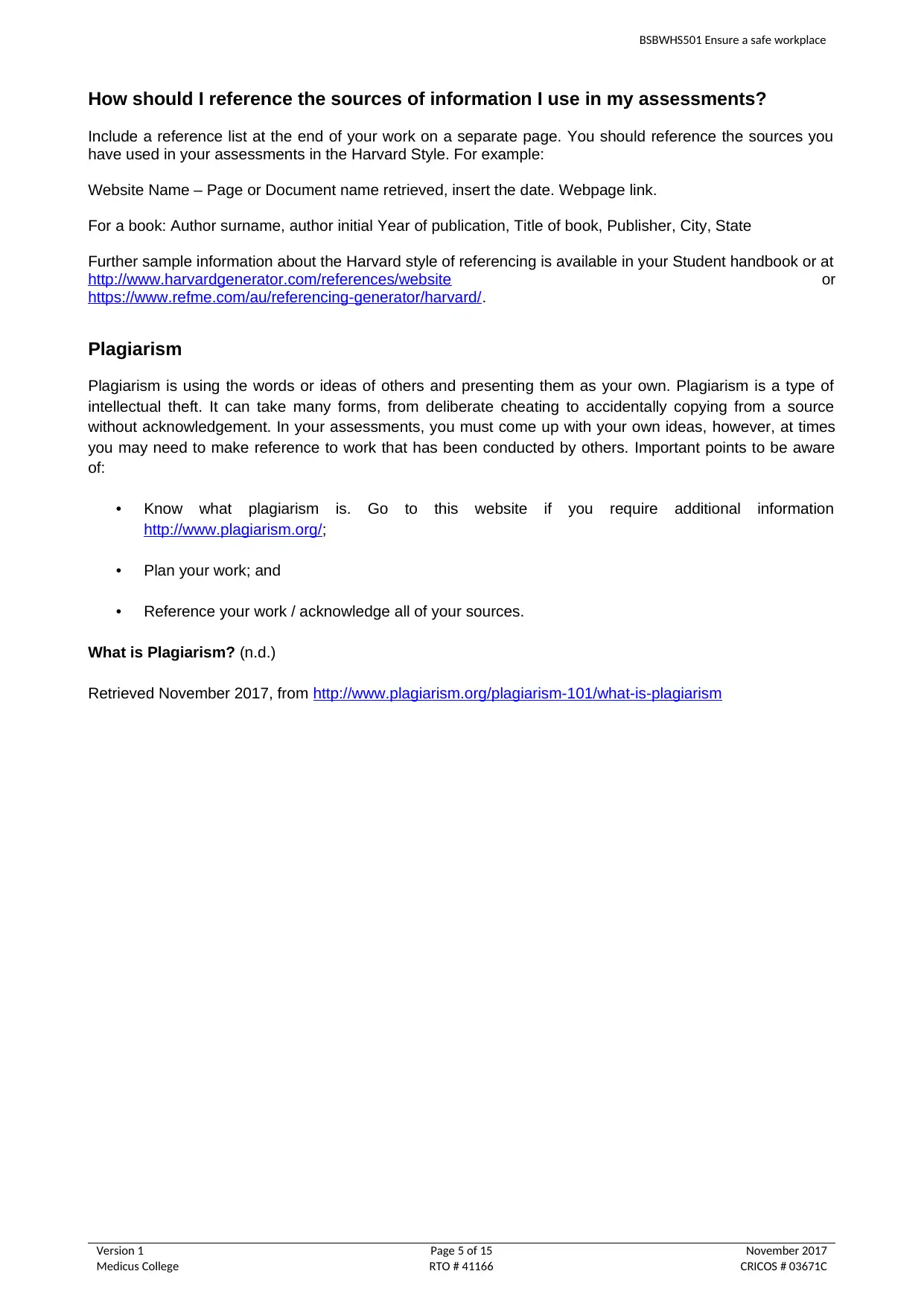
BSBWHS501 Ensure a safe workplace
How should I reference the sources of information I use in my assessments?
Include a reference list at the end of your work on a separate page. You should reference the sources you
have used in your assessments in the Harvard Style. For example:
Website Name – Page or Document name retrieved, insert the date. Webpage link.
For a book: Author surname, author initial Year of publication, Title of book, Publisher, City, State
Further sample information about the Harvard style of referencing is available in your Student handbook or at
http://www.harvardgenerator.com/references/website or
https://www.refme.com/au/referencing-generator/harvard/.
Plagiarism
Plagiarism is using the words or ideas of others and presenting them as your own. Plagiarism is a type of
intellectual theft. It can take many forms, from deliberate cheating to accidentally copying from a source
without acknowledgement. In your assessments, you must come up with your own ideas, however, at times
you may need to make reference to work that has been conducted by others. Important points to be aware
of:
• Know what plagiarism is. Go to this website if you require additional information
http://www.plagiarism.org/;
• Plan your work; and
• Reference your work / acknowledge all of your sources.
What is Plagiarism? (n.d.)
Retrieved November 2017, from http://www.plagiarism.org/plagiarism-101/what-is-plagiarism
Version 1 Page 5 of 15 November 2017
Medicus College RTO # 41166 CRICOS # 03671C
How should I reference the sources of information I use in my assessments?
Include a reference list at the end of your work on a separate page. You should reference the sources you
have used in your assessments in the Harvard Style. For example:
Website Name – Page or Document name retrieved, insert the date. Webpage link.
For a book: Author surname, author initial Year of publication, Title of book, Publisher, City, State
Further sample information about the Harvard style of referencing is available in your Student handbook or at
http://www.harvardgenerator.com/references/website or
https://www.refme.com/au/referencing-generator/harvard/.
Plagiarism
Plagiarism is using the words or ideas of others and presenting them as your own. Plagiarism is a type of
intellectual theft. It can take many forms, from deliberate cheating to accidentally copying from a source
without acknowledgement. In your assessments, you must come up with your own ideas, however, at times
you may need to make reference to work that has been conducted by others. Important points to be aware
of:
• Know what plagiarism is. Go to this website if you require additional information
http://www.plagiarism.org/;
• Plan your work; and
• Reference your work / acknowledge all of your sources.
What is Plagiarism? (n.d.)
Retrieved November 2017, from http://www.plagiarism.org/plagiarism-101/what-is-plagiarism
Version 1 Page 5 of 15 November 2017
Medicus College RTO # 41166 CRICOS # 03671C
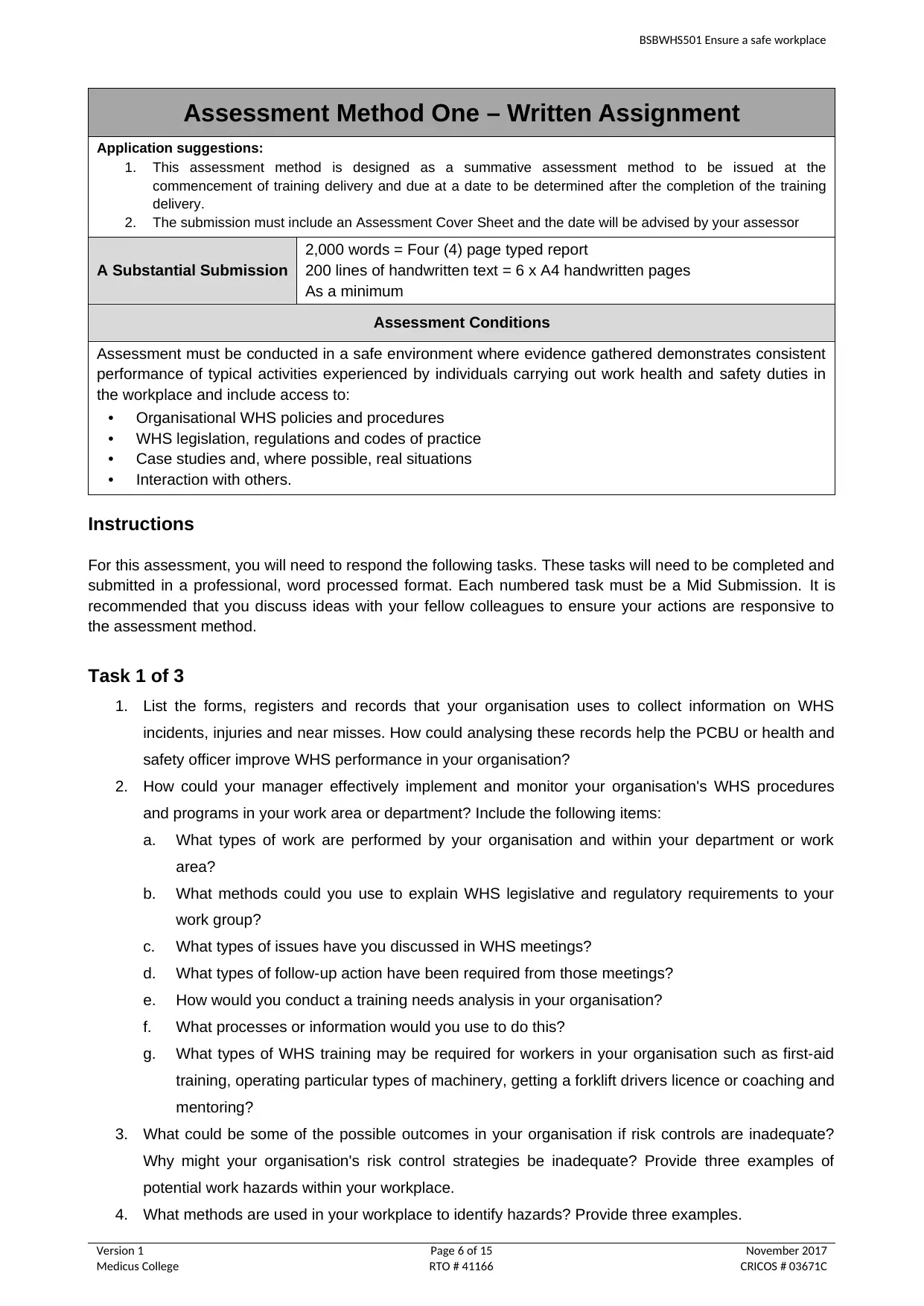
BSBWHS501 Ensure a safe workplace
Assessment Method One – Written Assignment
Application suggestions:
1. This assessment method is designed as a summative assessment method to be issued at the
commencement of training delivery and due at a date to be determined after the completion of the training
delivery.
2. The submission must include an Assessment Cover Sheet and the date will be advised by your assessor
A Substantial Submission
2,000 words = Four (4) page typed report
200 lines of handwritten text = 6 x A4 handwritten pages
As a minimum
Assessment Conditions
Assessment must be conducted in a safe environment where evidence gathered demonstrates consistent
performance of typical activities experienced by individuals carrying out work health and safety duties in
the workplace and include access to:
• Organisational WHS policies and procedures
• WHS legislation, regulations and codes of practice
• Case studies and, where possible, real situations
• Interaction with others.
Instructions
For this assessment, you will need to respond the following tasks. These tasks will need to be completed and
submitted in a professional, word processed format. Each numbered task must be a Mid Submission. It is
recommended that you discuss ideas with your fellow colleagues to ensure your actions are responsive to
the assessment method.
Task 1 of 3
1. List the forms, registers and records that your organisation uses to collect information on WHS
incidents, injuries and near misses. How could analysing these records help the PCBU or health and
safety officer improve WHS performance in your organisation?
2. How could your manager effectively implement and monitor your organisation's WHS procedures
and programs in your work area or department? Include the following items:
a. What types of work are performed by your organisation and within your department or work
area?
b. What methods could you use to explain WHS legislative and regulatory requirements to your
work group?
c. What types of issues have you discussed in WHS meetings?
d. What types of follow-up action have been required from those meetings?
e. How would you conduct a training needs analysis in your organisation?
f. What processes or information would you use to do this?
g. What types of WHS training may be required for workers in your organisation such as first-aid
training, operating particular types of machinery, getting a forklift drivers licence or coaching and
mentoring?
3. What could be some of the possible outcomes in your organisation if risk controls are inadequate?
Why might your organisation's risk control strategies be inadequate? Provide three examples of
potential work hazards within your workplace.
4. What methods are used in your workplace to identify hazards? Provide three examples.
Version 1 Page 6 of 15 November 2017
Medicus College RTO # 41166 CRICOS # 03671C
Assessment Method One – Written Assignment
Application suggestions:
1. This assessment method is designed as a summative assessment method to be issued at the
commencement of training delivery and due at a date to be determined after the completion of the training
delivery.
2. The submission must include an Assessment Cover Sheet and the date will be advised by your assessor
A Substantial Submission
2,000 words = Four (4) page typed report
200 lines of handwritten text = 6 x A4 handwritten pages
As a minimum
Assessment Conditions
Assessment must be conducted in a safe environment where evidence gathered demonstrates consistent
performance of typical activities experienced by individuals carrying out work health and safety duties in
the workplace and include access to:
• Organisational WHS policies and procedures
• WHS legislation, regulations and codes of practice
• Case studies and, where possible, real situations
• Interaction with others.
Instructions
For this assessment, you will need to respond the following tasks. These tasks will need to be completed and
submitted in a professional, word processed format. Each numbered task must be a Mid Submission. It is
recommended that you discuss ideas with your fellow colleagues to ensure your actions are responsive to
the assessment method.
Task 1 of 3
1. List the forms, registers and records that your organisation uses to collect information on WHS
incidents, injuries and near misses. How could analysing these records help the PCBU or health and
safety officer improve WHS performance in your organisation?
2. How could your manager effectively implement and monitor your organisation's WHS procedures
and programs in your work area or department? Include the following items:
a. What types of work are performed by your organisation and within your department or work
area?
b. What methods could you use to explain WHS legislative and regulatory requirements to your
work group?
c. What types of issues have you discussed in WHS meetings?
d. What types of follow-up action have been required from those meetings?
e. How would you conduct a training needs analysis in your organisation?
f. What processes or information would you use to do this?
g. What types of WHS training may be required for workers in your organisation such as first-aid
training, operating particular types of machinery, getting a forklift drivers licence or coaching and
mentoring?
3. What could be some of the possible outcomes in your organisation if risk controls are inadequate?
Why might your organisation's risk control strategies be inadequate? Provide three examples of
potential work hazards within your workplace.
4. What methods are used in your workplace to identify hazards? Provide three examples.
Version 1 Page 6 of 15 November 2017
Medicus College RTO # 41166 CRICOS # 03671C
⊘ This is a preview!⊘
Do you want full access?
Subscribe today to unlock all pages.

Trusted by 1+ million students worldwide
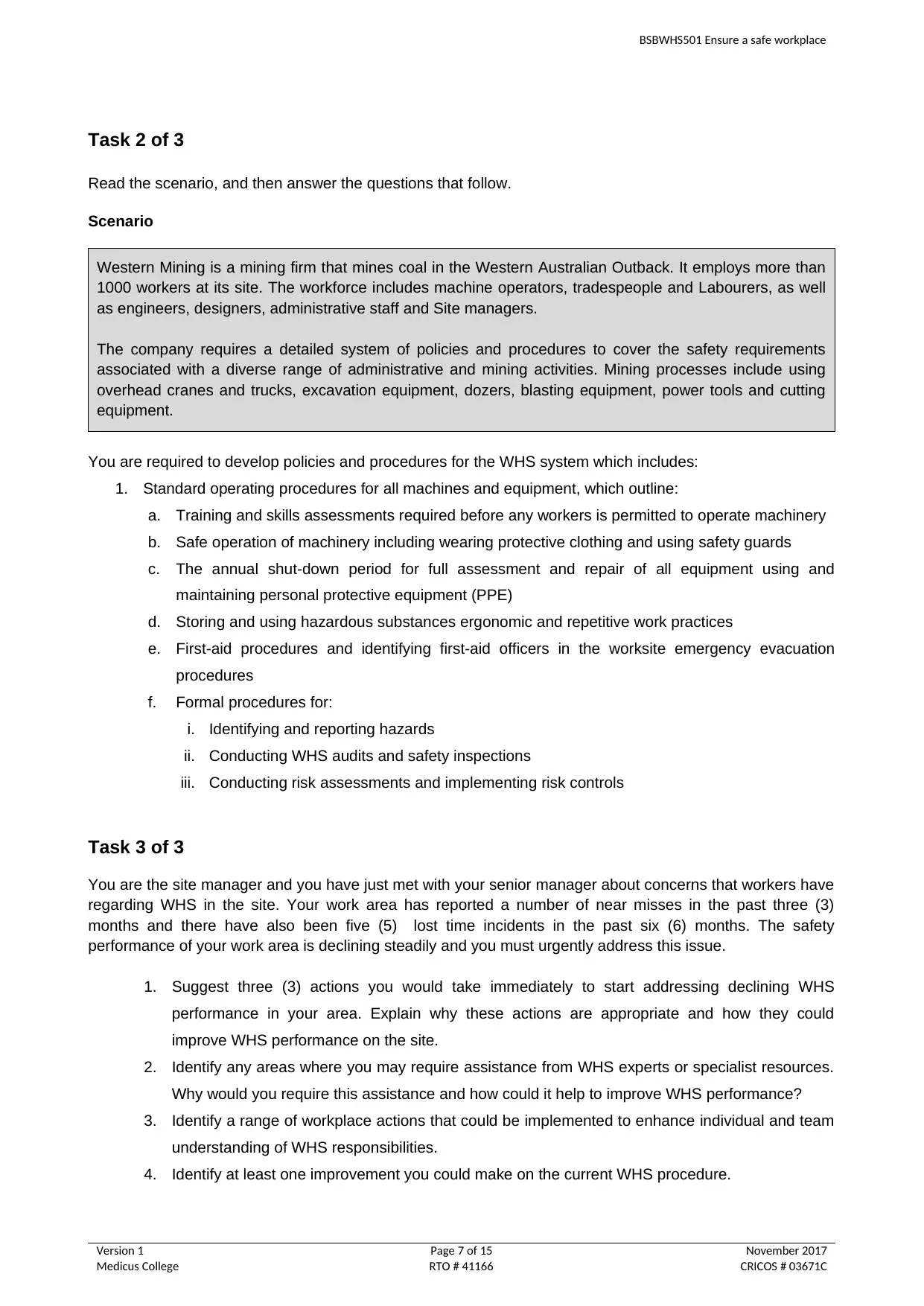
BSBWHS501 Ensure a safe workplace
Task 2 of 3
Read the scenario, and then answer the questions that follow.
Scenario
Western Mining is a mining firm that mines coal in the Western Australian Outback. It employs more than
1000 workers at its site. The workforce includes machine operators, tradespeople and Labourers, as well
as engineers, designers, administrative staff and Site managers.
The company requires a detailed system of policies and procedures to cover the safety requirements
associated with a diverse range of administrative and mining activities. Mining processes include using
overhead cranes and trucks, excavation equipment, dozers, blasting equipment, power tools and cutting
equipment.
You are required to develop policies and procedures for the WHS system which includes:
1. Standard operating procedures for all machines and equipment, which outline:
a. Training and skills assessments required before any workers is permitted to operate machinery
b. Safe operation of machinery including wearing protective clothing and using safety guards
c. The annual shut-down period for full assessment and repair of all equipment using and
maintaining personal protective equipment (PPE)
d. Storing and using hazardous substances ergonomic and repetitive work practices
e. First-aid procedures and identifying first-aid officers in the worksite emergency evacuation
procedures
f. Formal procedures for:
i. Identifying and reporting hazards
ii. Conducting WHS audits and safety inspections
iii. Conducting risk assessments and implementing risk controls
Task 3 of 3
You are the site manager and you have just met with your senior manager about concerns that workers have
regarding WHS in the site. Your work area has reported a number of near misses in the past three (3)
months and there have also been five (5) lost time incidents in the past six (6) months. The safety
performance of your work area is declining steadily and you must urgently address this issue.
1. Suggest three (3) actions you would take immediately to start addressing declining WHS
performance in your area. Explain why these actions are appropriate and how they could
improve WHS performance on the site.
2. Identify any areas where you may require assistance from WHS experts or specialist resources.
Why would you require this assistance and how could it help to improve WHS performance?
3. Identify a range of workplace actions that could be implemented to enhance individual and team
understanding of WHS responsibilities.
4. Identify at least one improvement you could make on the current WHS procedure.
Version 1 Page 7 of 15 November 2017
Medicus College RTO # 41166 CRICOS # 03671C
Task 2 of 3
Read the scenario, and then answer the questions that follow.
Scenario
Western Mining is a mining firm that mines coal in the Western Australian Outback. It employs more than
1000 workers at its site. The workforce includes machine operators, tradespeople and Labourers, as well
as engineers, designers, administrative staff and Site managers.
The company requires a detailed system of policies and procedures to cover the safety requirements
associated with a diverse range of administrative and mining activities. Mining processes include using
overhead cranes and trucks, excavation equipment, dozers, blasting equipment, power tools and cutting
equipment.
You are required to develop policies and procedures for the WHS system which includes:
1. Standard operating procedures for all machines and equipment, which outline:
a. Training and skills assessments required before any workers is permitted to operate machinery
b. Safe operation of machinery including wearing protective clothing and using safety guards
c. The annual shut-down period for full assessment and repair of all equipment using and
maintaining personal protective equipment (PPE)
d. Storing and using hazardous substances ergonomic and repetitive work practices
e. First-aid procedures and identifying first-aid officers in the worksite emergency evacuation
procedures
f. Formal procedures for:
i. Identifying and reporting hazards
ii. Conducting WHS audits and safety inspections
iii. Conducting risk assessments and implementing risk controls
Task 3 of 3
You are the site manager and you have just met with your senior manager about concerns that workers have
regarding WHS in the site. Your work area has reported a number of near misses in the past three (3)
months and there have also been five (5) lost time incidents in the past six (6) months. The safety
performance of your work area is declining steadily and you must urgently address this issue.
1. Suggest three (3) actions you would take immediately to start addressing declining WHS
performance in your area. Explain why these actions are appropriate and how they could
improve WHS performance on the site.
2. Identify any areas where you may require assistance from WHS experts or specialist resources.
Why would you require this assistance and how could it help to improve WHS performance?
3. Identify a range of workplace actions that could be implemented to enhance individual and team
understanding of WHS responsibilities.
4. Identify at least one improvement you could make on the current WHS procedure.
Version 1 Page 7 of 15 November 2017
Medicus College RTO # 41166 CRICOS # 03671C
Paraphrase This Document
Need a fresh take? Get an instant paraphrase of this document with our AI Paraphraser
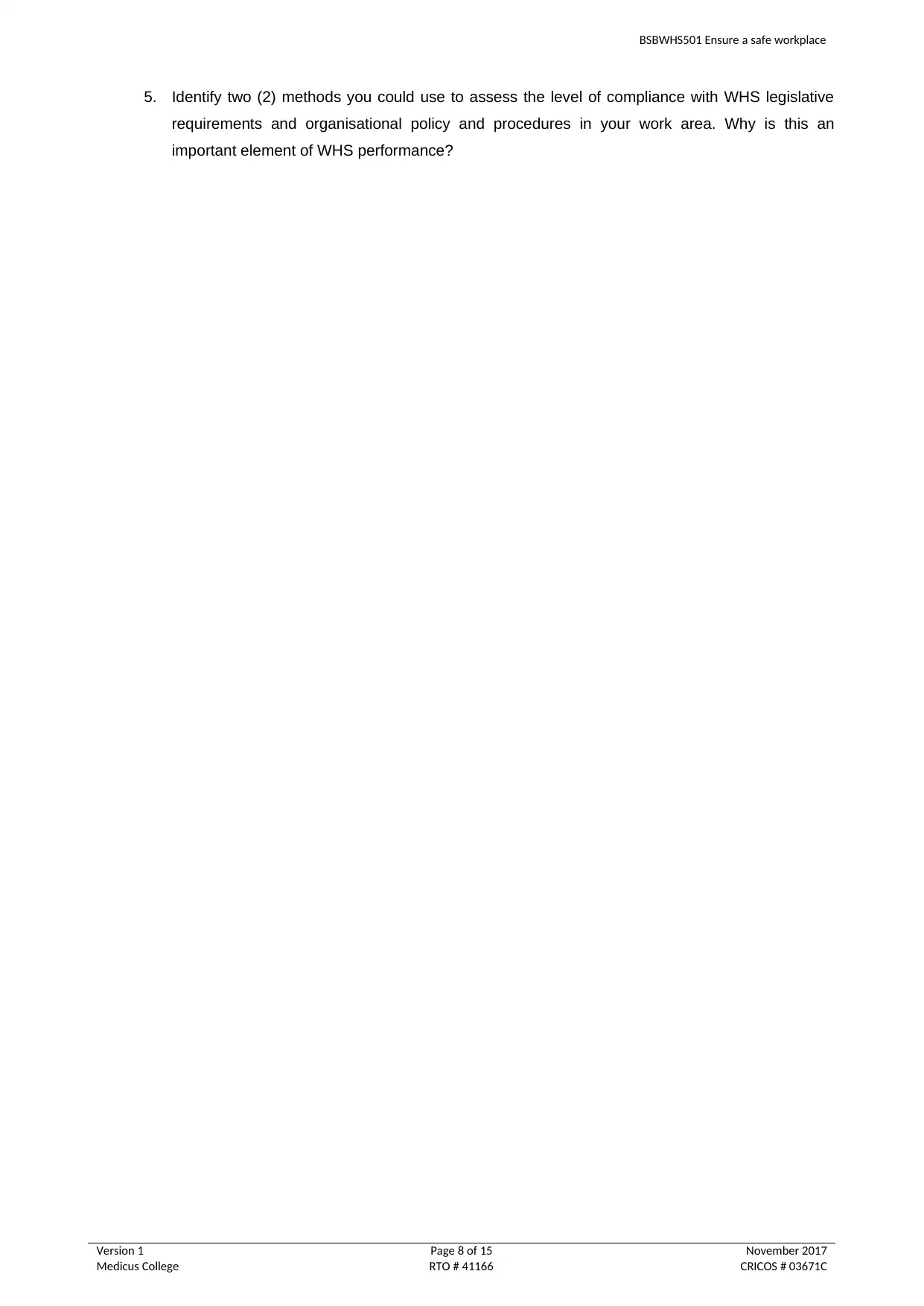
BSBWHS501 Ensure a safe workplace
5. Identify two (2) methods you could use to assess the level of compliance with WHS legislative
requirements and organisational policy and procedures in your work area. Why is this an
important element of WHS performance?
Version 1 Page 8 of 15 November 2017
Medicus College RTO # 41166 CRICOS # 03671C
5. Identify two (2) methods you could use to assess the level of compliance with WHS legislative
requirements and organisational policy and procedures in your work area. Why is this an
important element of WHS performance?
Version 1 Page 8 of 15 November 2017
Medicus College RTO # 41166 CRICOS # 03671C
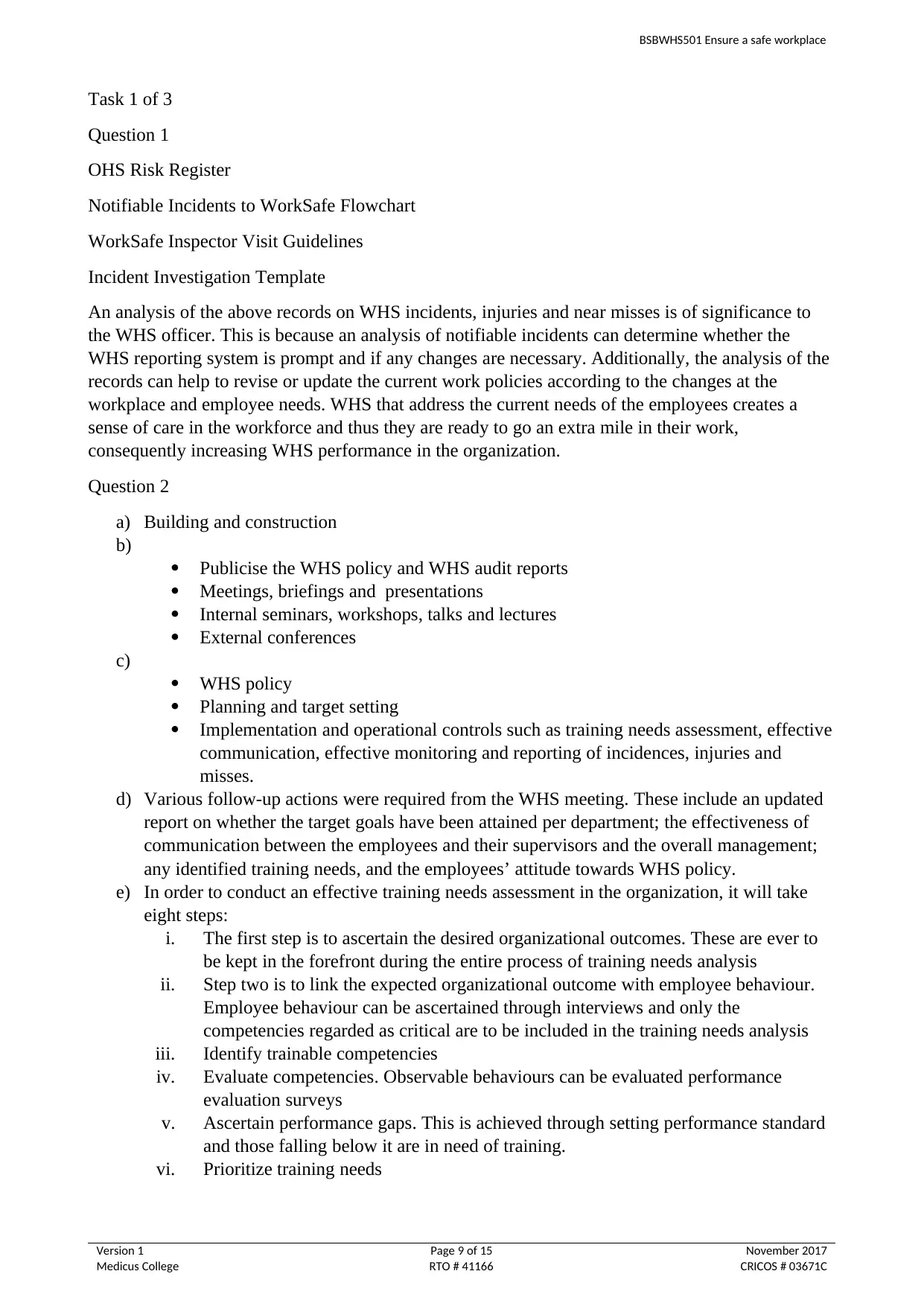
BSBWHS501 Ensure a safe workplace
Task 1 of 3
Question 1
OHS Risk Register
Notifiable Incidents to WorkSafe Flowchart
WorkSafe Inspector Visit Guidelines
Incident Investigation Template
An analysis of the above records on WHS incidents, injuries and near misses is of significance to
the WHS officer. This is because an analysis of notifiable incidents can determine whether the
WHS reporting system is prompt and if any changes are necessary. Additionally, the analysis of the
records can help to revise or update the current work policies according to the changes at the
workplace and employee needs. WHS that address the current needs of the employees creates a
sense of care in the workforce and thus they are ready to go an extra mile in their work,
consequently increasing WHS performance in the organization.
Question 2
a) Building and construction
b)
Publicise the WHS policy and WHS audit reports
Meetings, briefings and presentations
Internal seminars, workshops, talks and lectures
External conferences
c)
WHS policy
Planning and target setting
Implementation and operational controls such as training needs assessment, effective
communication, effective monitoring and reporting of incidences, injuries and
misses.
d) Various follow-up actions were required from the WHS meeting. These include an updated
report on whether the target goals have been attained per department; the effectiveness of
communication between the employees and their supervisors and the overall management;
any identified training needs, and the employees’ attitude towards WHS policy.
e) In order to conduct an effective training needs assessment in the organization, it will take
eight steps:
i. The first step is to ascertain the desired organizational outcomes. These are ever to
be kept in the forefront during the entire process of training needs analysis
ii. Step two is to link the expected organizational outcome with employee behaviour.
Employee behaviour can be ascertained through interviews and only the
competencies regarded as critical are to be included in the training needs analysis
iii. Identify trainable competencies
iv. Evaluate competencies. Observable behaviours can be evaluated performance
evaluation surveys
v. Ascertain performance gaps. This is achieved through setting performance standard
and those falling below it are in need of training.
vi. Prioritize training needs
Version 1 Page 9 of 15 November 2017
Medicus College RTO # 41166 CRICOS # 03671C
Task 1 of 3
Question 1
OHS Risk Register
Notifiable Incidents to WorkSafe Flowchart
WorkSafe Inspector Visit Guidelines
Incident Investigation Template
An analysis of the above records on WHS incidents, injuries and near misses is of significance to
the WHS officer. This is because an analysis of notifiable incidents can determine whether the
WHS reporting system is prompt and if any changes are necessary. Additionally, the analysis of the
records can help to revise or update the current work policies according to the changes at the
workplace and employee needs. WHS that address the current needs of the employees creates a
sense of care in the workforce and thus they are ready to go an extra mile in their work,
consequently increasing WHS performance in the organization.
Question 2
a) Building and construction
b)
Publicise the WHS policy and WHS audit reports
Meetings, briefings and presentations
Internal seminars, workshops, talks and lectures
External conferences
c)
WHS policy
Planning and target setting
Implementation and operational controls such as training needs assessment, effective
communication, effective monitoring and reporting of incidences, injuries and
misses.
d) Various follow-up actions were required from the WHS meeting. These include an updated
report on whether the target goals have been attained per department; the effectiveness of
communication between the employees and their supervisors and the overall management;
any identified training needs, and the employees’ attitude towards WHS policy.
e) In order to conduct an effective training needs assessment in the organization, it will take
eight steps:
i. The first step is to ascertain the desired organizational outcomes. These are ever to
be kept in the forefront during the entire process of training needs analysis
ii. Step two is to link the expected organizational outcome with employee behaviour.
Employee behaviour can be ascertained through interviews and only the
competencies regarded as critical are to be included in the training needs analysis
iii. Identify trainable competencies
iv. Evaluate competencies. Observable behaviours can be evaluated performance
evaluation surveys
v. Ascertain performance gaps. This is achieved through setting performance standard
and those falling below it are in need of training.
vi. Prioritize training needs
Version 1 Page 9 of 15 November 2017
Medicus College RTO # 41166 CRICOS # 03671C
⊘ This is a preview!⊘
Do you want full access?
Subscribe today to unlock all pages.

Trusted by 1+ million students worldwide
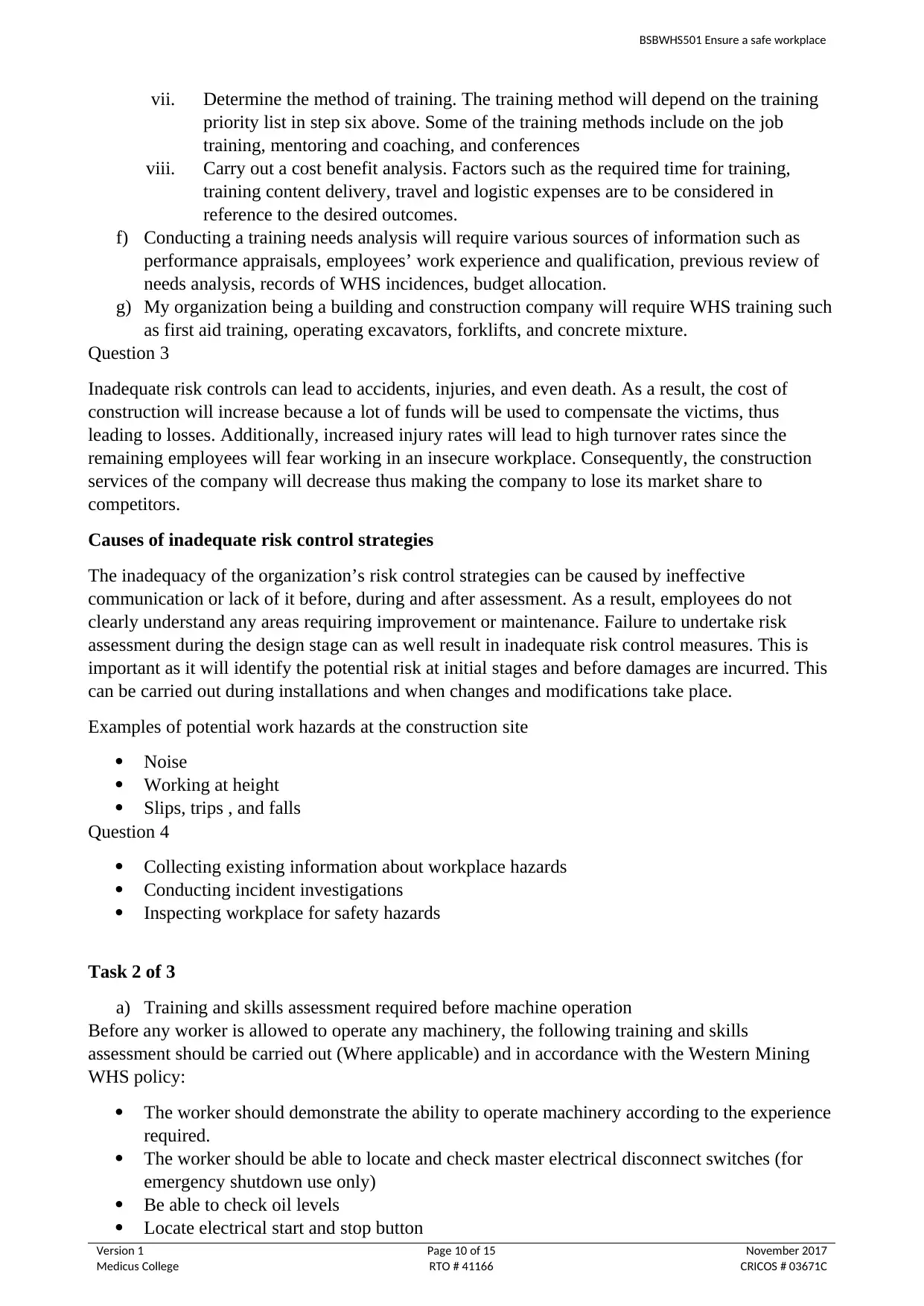
BSBWHS501 Ensure a safe workplace
vii. Determine the method of training. The training method will depend on the training
priority list in step six above. Some of the training methods include on the job
training, mentoring and coaching, and conferences
viii. Carry out a cost benefit analysis. Factors such as the required time for training,
training content delivery, travel and logistic expenses are to be considered in
reference to the desired outcomes.
f) Conducting a training needs analysis will require various sources of information such as
performance appraisals, employees’ work experience and qualification, previous review of
needs analysis, records of WHS incidences, budget allocation.
g) My organization being a building and construction company will require WHS training such
as first aid training, operating excavators, forklifts, and concrete mixture.
Question 3
Inadequate risk controls can lead to accidents, injuries, and even death. As a result, the cost of
construction will increase because a lot of funds will be used to compensate the victims, thus
leading to losses. Additionally, increased injury rates will lead to high turnover rates since the
remaining employees will fear working in an insecure workplace. Consequently, the construction
services of the company will decrease thus making the company to lose its market share to
competitors.
Causes of inadequate risk control strategies
The inadequacy of the organization’s risk control strategies can be caused by ineffective
communication or lack of it before, during and after assessment. As a result, employees do not
clearly understand any areas requiring improvement or maintenance. Failure to undertake risk
assessment during the design stage can as well result in inadequate risk control measures. This is
important as it will identify the potential risk at initial stages and before damages are incurred. This
can be carried out during installations and when changes and modifications take place.
Examples of potential work hazards at the construction site
Noise
Working at height
Slips, trips , and falls
Question 4
Collecting existing information about workplace hazards
Conducting incident investigations
Inspecting workplace for safety hazards
Task 2 of 3
a) Training and skills assessment required before machine operation
Before any worker is allowed to operate any machinery, the following training and skills
assessment should be carried out (Where applicable) and in accordance with the Western Mining
WHS policy:
The worker should demonstrate the ability to operate machinery according to the experience
required.
The worker should be able to locate and check master electrical disconnect switches (for
emergency shutdown use only)
Be able to check oil levels
Locate electrical start and stop button
Version 1 Page 10 of 15 November 2017
Medicus College RTO # 41166 CRICOS # 03671C
vii. Determine the method of training. The training method will depend on the training
priority list in step six above. Some of the training methods include on the job
training, mentoring and coaching, and conferences
viii. Carry out a cost benefit analysis. Factors such as the required time for training,
training content delivery, travel and logistic expenses are to be considered in
reference to the desired outcomes.
f) Conducting a training needs analysis will require various sources of information such as
performance appraisals, employees’ work experience and qualification, previous review of
needs analysis, records of WHS incidences, budget allocation.
g) My organization being a building and construction company will require WHS training such
as first aid training, operating excavators, forklifts, and concrete mixture.
Question 3
Inadequate risk controls can lead to accidents, injuries, and even death. As a result, the cost of
construction will increase because a lot of funds will be used to compensate the victims, thus
leading to losses. Additionally, increased injury rates will lead to high turnover rates since the
remaining employees will fear working in an insecure workplace. Consequently, the construction
services of the company will decrease thus making the company to lose its market share to
competitors.
Causes of inadequate risk control strategies
The inadequacy of the organization’s risk control strategies can be caused by ineffective
communication or lack of it before, during and after assessment. As a result, employees do not
clearly understand any areas requiring improvement or maintenance. Failure to undertake risk
assessment during the design stage can as well result in inadequate risk control measures. This is
important as it will identify the potential risk at initial stages and before damages are incurred. This
can be carried out during installations and when changes and modifications take place.
Examples of potential work hazards at the construction site
Noise
Working at height
Slips, trips , and falls
Question 4
Collecting existing information about workplace hazards
Conducting incident investigations
Inspecting workplace for safety hazards
Task 2 of 3
a) Training and skills assessment required before machine operation
Before any worker is allowed to operate any machinery, the following training and skills
assessment should be carried out (Where applicable) and in accordance with the Western Mining
WHS policy:
The worker should demonstrate the ability to operate machinery according to the experience
required.
The worker should be able to locate and check master electrical disconnect switches (for
emergency shutdown use only)
Be able to check oil levels
Locate electrical start and stop button
Version 1 Page 10 of 15 November 2017
Medicus College RTO # 41166 CRICOS # 03671C
Paraphrase This Document
Need a fresh take? Get an instant paraphrase of this document with our AI Paraphraser
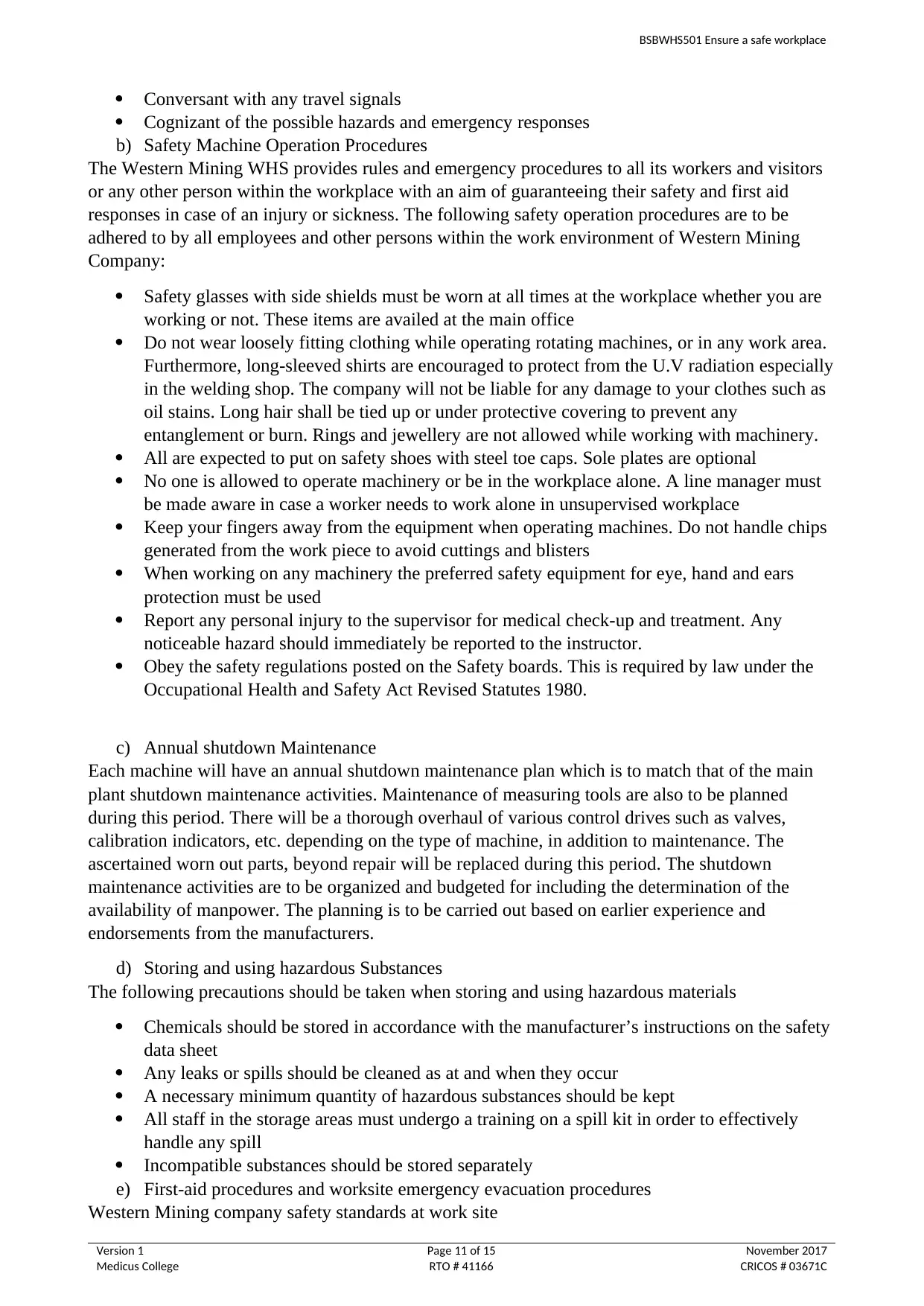
BSBWHS501 Ensure a safe workplace
Conversant with any travel signals
Cognizant of the possible hazards and emergency responses
b) Safety Machine Operation Procedures
The Western Mining WHS provides rules and emergency procedures to all its workers and visitors
or any other person within the workplace with an aim of guaranteeing their safety and first aid
responses in case of an injury or sickness. The following safety operation procedures are to be
adhered to by all employees and other persons within the work environment of Western Mining
Company:
Safety glasses with side shields must be worn at all times at the workplace whether you are
working or not. These items are availed at the main office
Do not wear loosely fitting clothing while operating rotating machines, or in any work area.
Furthermore, long-sleeved shirts are encouraged to protect from the U.V radiation especially
in the welding shop. The company will not be liable for any damage to your clothes such as
oil stains. Long hair shall be tied up or under protective covering to prevent any
entanglement or burn. Rings and jewellery are not allowed while working with machinery.
All are expected to put on safety shoes with steel toe caps. Sole plates are optional
No one is allowed to operate machinery or be in the workplace alone. A line manager must
be made aware in case a worker needs to work alone in unsupervised workplace
Keep your fingers away from the equipment when operating machines. Do not handle chips
generated from the work piece to avoid cuttings and blisters
When working on any machinery the preferred safety equipment for eye, hand and ears
protection must be used
Report any personal injury to the supervisor for medical check-up and treatment. Any
noticeable hazard should immediately be reported to the instructor.
Obey the safety regulations posted on the Safety boards. This is required by law under the
Occupational Health and Safety Act Revised Statutes 1980.
c) Annual shutdown Maintenance
Each machine will have an annual shutdown maintenance plan which is to match that of the main
plant shutdown maintenance activities. Maintenance of measuring tools are also to be planned
during this period. There will be a thorough overhaul of various control drives such as valves,
calibration indicators, etc. depending on the type of machine, in addition to maintenance. The
ascertained worn out parts, beyond repair will be replaced during this period. The shutdown
maintenance activities are to be organized and budgeted for including the determination of the
availability of manpower. The planning is to be carried out based on earlier experience and
endorsements from the manufacturers.
d) Storing and using hazardous Substances
The following precautions should be taken when storing and using hazardous materials
Chemicals should be stored in accordance with the manufacturer’s instructions on the safety
data sheet
Any leaks or spills should be cleaned as at and when they occur
A necessary minimum quantity of hazardous substances should be kept
All staff in the storage areas must undergo a training on a spill kit in order to effectively
handle any spill
Incompatible substances should be stored separately
e) First-aid procedures and worksite emergency evacuation procedures
Western Mining company safety standards at work site
Version 1 Page 11 of 15 November 2017
Medicus College RTO # 41166 CRICOS # 03671C
Conversant with any travel signals
Cognizant of the possible hazards and emergency responses
b) Safety Machine Operation Procedures
The Western Mining WHS provides rules and emergency procedures to all its workers and visitors
or any other person within the workplace with an aim of guaranteeing their safety and first aid
responses in case of an injury or sickness. The following safety operation procedures are to be
adhered to by all employees and other persons within the work environment of Western Mining
Company:
Safety glasses with side shields must be worn at all times at the workplace whether you are
working or not. These items are availed at the main office
Do not wear loosely fitting clothing while operating rotating machines, or in any work area.
Furthermore, long-sleeved shirts are encouraged to protect from the U.V radiation especially
in the welding shop. The company will not be liable for any damage to your clothes such as
oil stains. Long hair shall be tied up or under protective covering to prevent any
entanglement or burn. Rings and jewellery are not allowed while working with machinery.
All are expected to put on safety shoes with steel toe caps. Sole plates are optional
No one is allowed to operate machinery or be in the workplace alone. A line manager must
be made aware in case a worker needs to work alone in unsupervised workplace
Keep your fingers away from the equipment when operating machines. Do not handle chips
generated from the work piece to avoid cuttings and blisters
When working on any machinery the preferred safety equipment for eye, hand and ears
protection must be used
Report any personal injury to the supervisor for medical check-up and treatment. Any
noticeable hazard should immediately be reported to the instructor.
Obey the safety regulations posted on the Safety boards. This is required by law under the
Occupational Health and Safety Act Revised Statutes 1980.
c) Annual shutdown Maintenance
Each machine will have an annual shutdown maintenance plan which is to match that of the main
plant shutdown maintenance activities. Maintenance of measuring tools are also to be planned
during this period. There will be a thorough overhaul of various control drives such as valves,
calibration indicators, etc. depending on the type of machine, in addition to maintenance. The
ascertained worn out parts, beyond repair will be replaced during this period. The shutdown
maintenance activities are to be organized and budgeted for including the determination of the
availability of manpower. The planning is to be carried out based on earlier experience and
endorsements from the manufacturers.
d) Storing and using hazardous Substances
The following precautions should be taken when storing and using hazardous materials
Chemicals should be stored in accordance with the manufacturer’s instructions on the safety
data sheet
Any leaks or spills should be cleaned as at and when they occur
A necessary minimum quantity of hazardous substances should be kept
All staff in the storage areas must undergo a training on a spill kit in order to effectively
handle any spill
Incompatible substances should be stored separately
e) First-aid procedures and worksite emergency evacuation procedures
Western Mining company safety standards at work site
Version 1 Page 11 of 15 November 2017
Medicus College RTO # 41166 CRICOS # 03671C
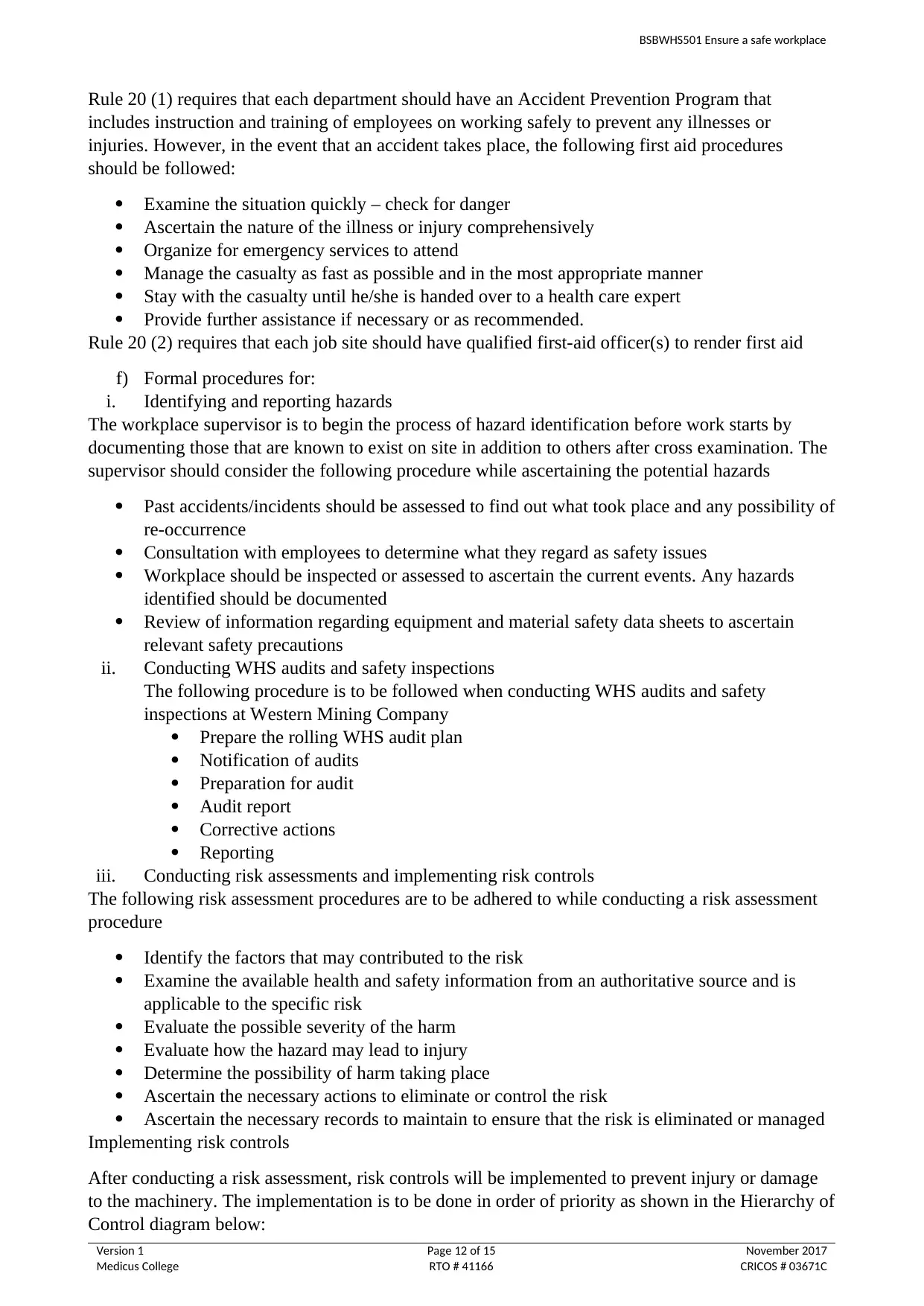
BSBWHS501 Ensure a safe workplace
Rule 20 (1) requires that each department should have an Accident Prevention Program that
includes instruction and training of employees on working safely to prevent any illnesses or
injuries. However, in the event that an accident takes place, the following first aid procedures
should be followed:
Examine the situation quickly – check for danger
Ascertain the nature of the illness or injury comprehensively
Organize for emergency services to attend
Manage the casualty as fast as possible and in the most appropriate manner
Stay with the casualty until he/she is handed over to a health care expert
Provide further assistance if necessary or as recommended.
Rule 20 (2) requires that each job site should have qualified first-aid officer(s) to render first aid
f) Formal procedures for:
i. Identifying and reporting hazards
The workplace supervisor is to begin the process of hazard identification before work starts by
documenting those that are known to exist on site in addition to others after cross examination. The
supervisor should consider the following procedure while ascertaining the potential hazards
Past accidents/incidents should be assessed to find out what took place and any possibility of
re-occurrence
Consultation with employees to determine what they regard as safety issues
Workplace should be inspected or assessed to ascertain the current events. Any hazards
identified should be documented
Review of information regarding equipment and material safety data sheets to ascertain
relevant safety precautions
ii. Conducting WHS audits and safety inspections
The following procedure is to be followed when conducting WHS audits and safety
inspections at Western Mining Company
Prepare the rolling WHS audit plan
Notification of audits
Preparation for audit
Audit report
Corrective actions
Reporting
iii. Conducting risk assessments and implementing risk controls
The following risk assessment procedures are to be adhered to while conducting a risk assessment
procedure
Identify the factors that may contributed to the risk
Examine the available health and safety information from an authoritative source and is
applicable to the specific risk
Evaluate the possible severity of the harm
Evaluate how the hazard may lead to injury
Determine the possibility of harm taking place
Ascertain the necessary actions to eliminate or control the risk
Ascertain the necessary records to maintain to ensure that the risk is eliminated or managed
Implementing risk controls
After conducting a risk assessment, risk controls will be implemented to prevent injury or damage
to the machinery. The implementation is to be done in order of priority as shown in the Hierarchy of
Control diagram below:
Version 1 Page 12 of 15 November 2017
Medicus College RTO # 41166 CRICOS # 03671C
Rule 20 (1) requires that each department should have an Accident Prevention Program that
includes instruction and training of employees on working safely to prevent any illnesses or
injuries. However, in the event that an accident takes place, the following first aid procedures
should be followed:
Examine the situation quickly – check for danger
Ascertain the nature of the illness or injury comprehensively
Organize for emergency services to attend
Manage the casualty as fast as possible and in the most appropriate manner
Stay with the casualty until he/she is handed over to a health care expert
Provide further assistance if necessary or as recommended.
Rule 20 (2) requires that each job site should have qualified first-aid officer(s) to render first aid
f) Formal procedures for:
i. Identifying and reporting hazards
The workplace supervisor is to begin the process of hazard identification before work starts by
documenting those that are known to exist on site in addition to others after cross examination. The
supervisor should consider the following procedure while ascertaining the potential hazards
Past accidents/incidents should be assessed to find out what took place and any possibility of
re-occurrence
Consultation with employees to determine what they regard as safety issues
Workplace should be inspected or assessed to ascertain the current events. Any hazards
identified should be documented
Review of information regarding equipment and material safety data sheets to ascertain
relevant safety precautions
ii. Conducting WHS audits and safety inspections
The following procedure is to be followed when conducting WHS audits and safety
inspections at Western Mining Company
Prepare the rolling WHS audit plan
Notification of audits
Preparation for audit
Audit report
Corrective actions
Reporting
iii. Conducting risk assessments and implementing risk controls
The following risk assessment procedures are to be adhered to while conducting a risk assessment
procedure
Identify the factors that may contributed to the risk
Examine the available health and safety information from an authoritative source and is
applicable to the specific risk
Evaluate the possible severity of the harm
Evaluate how the hazard may lead to injury
Determine the possibility of harm taking place
Ascertain the necessary actions to eliminate or control the risk
Ascertain the necessary records to maintain to ensure that the risk is eliminated or managed
Implementing risk controls
After conducting a risk assessment, risk controls will be implemented to prevent injury or damage
to the machinery. The implementation is to be done in order of priority as shown in the Hierarchy of
Control diagram below:
Version 1 Page 12 of 15 November 2017
Medicus College RTO # 41166 CRICOS # 03671C
⊘ This is a preview!⊘
Do you want full access?
Subscribe today to unlock all pages.

Trusted by 1+ million students worldwide
1 out of 15
Related Documents
Your All-in-One AI-Powered Toolkit for Academic Success.
+13062052269
info@desklib.com
Available 24*7 on WhatsApp / Email
![[object Object]](/_next/static/media/star-bottom.7253800d.svg)
Unlock your academic potential
Copyright © 2020–2025 A2Z Services. All Rights Reserved. Developed and managed by ZUCOL.





